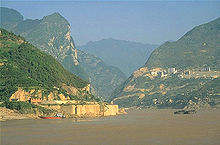Three Gorges
| Three Gorges | |||||||||||||||||||

The Yangtze in the Three Gorges region.
|
|||||||||||||||||||
| Simplified Chinese | 三峡 | ||||||||||||||||||
|---|---|---|---|---|---|---|---|---|---|---|---|---|---|---|---|---|---|---|---|
| Traditional Chinese | 三峽 | ||||||||||||||||||
|
|||||||||||||||||||
| Transcriptions | |
|---|---|
| Standard Mandarin | |
| Hanyu Pinyin | |
| Wade–Giles | San1-hsia2 |
| IPA | [sánɕjǎ] |
| Yue: Cantonese | |
| Jyutping | Sam1-haap6 |
| Southern Min | |
| Tâi-lô | Sam-kiap |
The Three Gorges (Chinese: 三峡; pinyin: ![]() Sānxiá) are three adjacent gorges along the middle reaches of the Yangtze River in the People's Republic of China. The Three Gorges have long been renowned for their spectacular scenery, and the "Three Gorges Scenic Area" is classified as a AAAAA scenic area (the highest level) by the China National Tourism Administration.
Sānxiá) are three adjacent gorges along the middle reaches of the Yangtze River in the People's Republic of China. The Three Gorges have long been renowned for their spectacular scenery, and the "Three Gorges Scenic Area" is classified as a AAAAA scenic area (the highest level) by the China National Tourism Administration.
The Three Gorges span from the western—upriver cities of Fengjie and Yichang in Chongqing Municipality eastward—downstream to Hubei province The Three Gorges region attracts global attention due to the Three Gorges Dam, which is firmly changing the culture and environment of the river and Three Gorges region.
The Yangtze River (Chang Jiang)—Three Gorges region has a total length of approximately 200 kilometres (120 mi). The Three Gorges occupy approximately 120 kilometres (75 mi) within this region. Although it is primarily famous for its scenery, the Three Gorges region is also a historically and culturally important location in China. Many settlements and archeological sites are under submersion from the rising Three Gorges Dam.
...
Wikipedia
